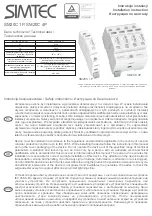
64
3D FUNCTION
•
Warning about photosensitivity seizures
-
Some users may experience a seizure or other abnormal symptoms
when they are exposed to a flashing light or particular patterns from
a video game. If anyone in your family has a history of epilepsy or
has ever experienced any kind of seizure, please consult your doctor
before viewing 3D images.
If you experience one of the following symptoms while watching a 3D
video, stop watching the 3D video immediately and take a rest.
-
Dizziness, switched eyesight, twitching of the eye or facial muscles,
involuntary movements, cramp, loss of consciousness, confusion,
loss of sense of direction, or nausea. If the symptom does not
disappear, please consult your doctor.
•
You can reduce the risk of photosensitive seizures by taking the
following preventive measures.
-
Take a rest of 5 to 15 mins. for every 1 hour of viewing.
-
If vision varies between each eye, correct the variation before
beginning to watch a 3D video.
-
Ensure that the 3D video is directly in front of you, at eye level.
-
You should stop watching if you experience a headache, fatigue, or
dizziness.
-
Do not view 3D images for a long period of time when you are tired
or ill.
CAUTION
•
Extra special care is required for children watching a 3D video.
When Watching 3D Video
•
Prevent children of 5 years or younger from watching a 3D video. It may
impair the development of their eyes.
•
Children 10 years old or younger are still developing their eyesight and
may have an excessive tendency to touch or jump at the screen. Adult
guidance and supervision is recommended.
•
Since the distance between the eyes is narrower for children than in
adults, children tend to notice a greater difference in the images seen by
each eye. Therefore, even while watching the same 3D video, children
may have a greater depth perception than adults.
•
Children under 19 years old or younger may respond with sensitivity to
the light stimuli of 3D content. Excessive viewing when fatigued is not
recommended.
















































